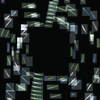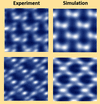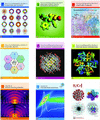issue contents
November 2020 issue

Cover illustration: In this issue, Fang et al. [Acta Cryst. (2020), A76, 652-663] present a flexible and standalone forward simulation model to compute diffraction projections for laboratory X-ray diffraction contrast tomography, which is a novel technique for non-destructive 3D characterization of grain structures in bulk materials. With this modelling tool detailed analysis of diffraction spots as a function of grain sizes and lattice-plane families for samples with any crystal structure becomes simple and robust. The image shows the simulated diffraction spots (top left), the experimental ones (bottom left) and the comparisons between them (right) for the same grain diffracting at a series of sample rotation angles.
foundations
research papers
 access
accessElectron image contrast analysis of mosaicity in rutile nanocrystals using direct electron detection
 access
accessinternational union of crystallography


book reviews



 journal menu
journal menu






























